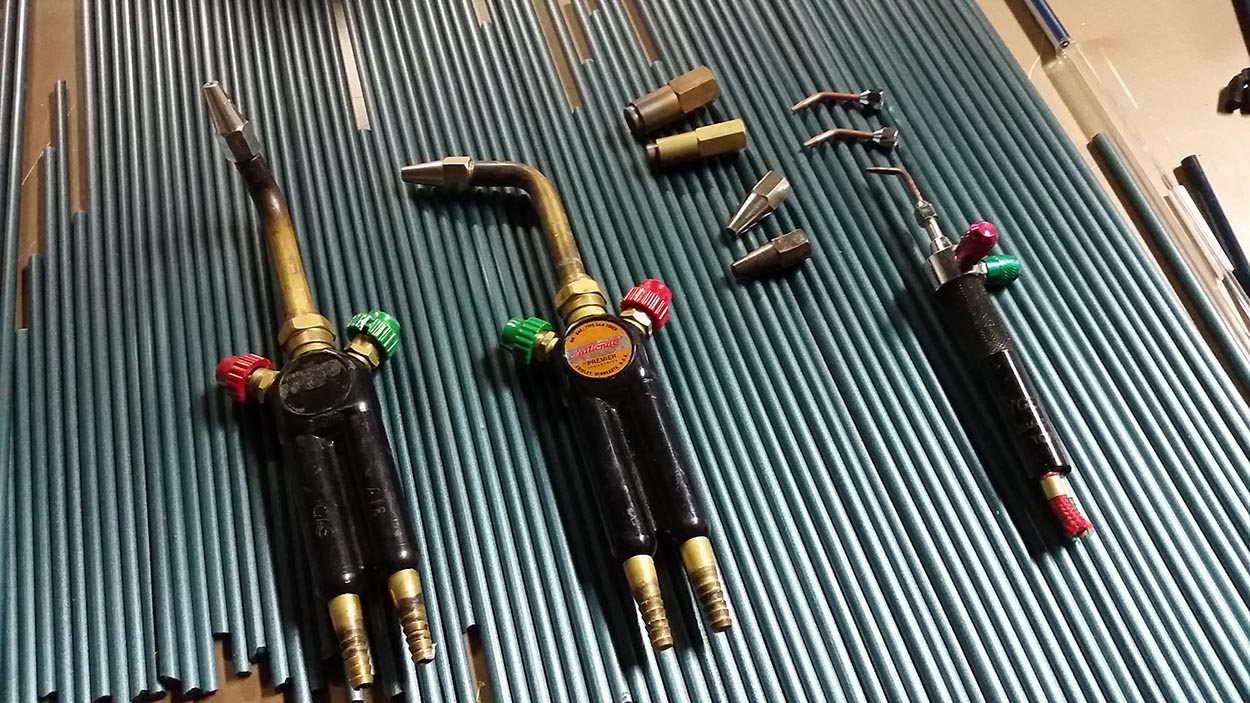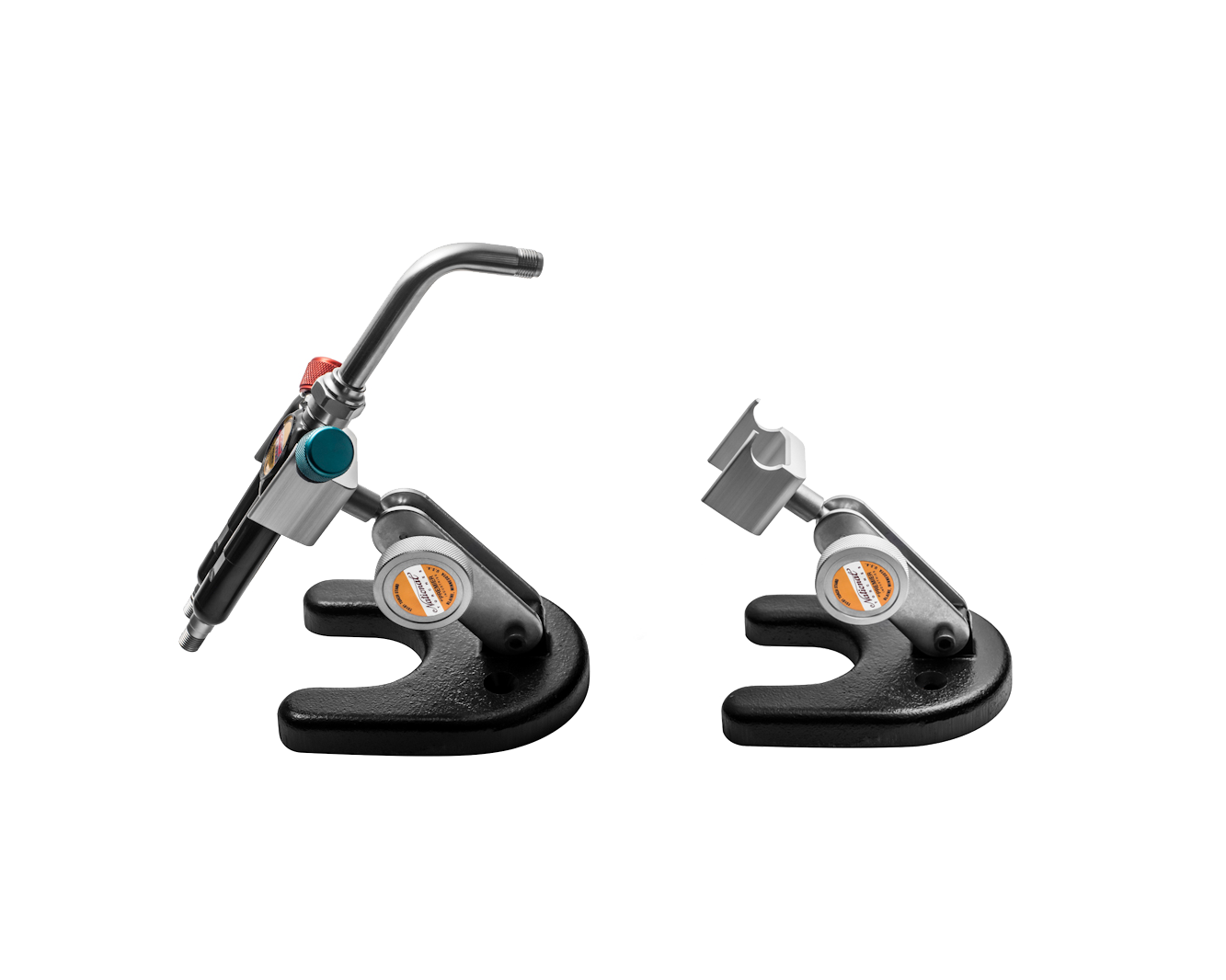Torches and burners are of two styles being surface-mix or pre-mix. The difference is where the mixing of the fuel gas and oxygen take place. Remember, your torch will be burning oxygen and propane or natural gas. Do not use torch components designed for use with air as oxygen is very corrosive and requires the proper materials.Pre-mix torches, as a rule, are capable of burning a little hotter with a flame that can be very concentrated. The new generation of surface mix torch like GTT have figured out how to make a really really hot flame with being a surface mix torch. For pre mix torches gas and oxygen are mixed in a chamber within the torch body. This style torch is preferred when making seals and/or when heating small concentrated areas. If you were to be restricted to using only one torch, the pre-mix is recommended. Premix torches have the benefit of having interchangeable tips, allowing the user the option of changing flame characteristics over a broad range. A torch used quite extensively in the industry is the
National Handtorch Type 3A Blowpipeshown here. This relatively inexpensive torch, with tip sizes #2, 3, 4,and 5 will cover most of your hobby glassblowing needs.

Surface-mix torches and burners are used most frequently when large areas of glass need to be worked. The surface mix torches also burn much quieter. Oxygen and fuel gases are mixed at the torch tip. The flame characteristics tend to be broader and softer, with less velocity than a comparably sized flame from the pre-mix torch. This is a good torch to use when preheating a large piece of glass apparatus for repair, or when shaping large tubing. An excellent example of a burner that incorporates surface-mix and pre-mix capabilities would be the
Carlisle CC Burner, and the
GTT.
There are many other makes and models of torches available to the glassblower. Their different flame and body characteristics determine their application in the glassblowing field.
Handheld glassblowing torches may be used as burners by simply hanging or attaching them to some sort of fixture. This fixture may be something as simple as a ring-stand and clamp assembly or a custom made unit that will hold the torch in a safe and secure manner.

Get To Know Your Glassblowing Tools
Handle the tools you will be using. Feel their weight and balance, learn how to hold them in a comfortable manner, and how see how easy/hard it is to open and close valves on your torch and burners. Remember to never overtighten your torch valves as this can cause them to leak over time leading to a rebuild of the torch valves.
Always wear your safety/didymium glasses when at the work bench.Review all safety procedures before you plan or start your work. Think out what it is that you will be doing and know what action to take if something happens differently than expected. Read through the instruction text to prepare for the exercise. It is best to avoid surprises at this stage of instruction! Knowing what could happen and preparing for the worst case is the best preparedness you can do.
Fire Up The Torch
In the following discussion, we will assume that you are using a National Handtorch with a #3 tip. The steps to lighting your torch are:
- Confirm gas delivery systems are in safe operating condition.
- Open the gas valve one full turn to purge air from the line and then quickly close the valve.
- Repeat step #2 with oxygen.
- Open the gas valve approximately 1/4 turn and then ignite the gas with your flint lighter, or we like a zippo lighter. NEVER EVER use a butane lighter such as a bic lighter. This can overheat and potentially explode. Smokers should keep their lighters in their car or another room other than at the torch bench.
- The torch is lit! Adjust the gas valve to produce a flame about 3/4" long. This is known as a pilot flame. You may leave the torch flame at this position when not in use - but always attended.
Differnet torches light differntly, but overall they light the same. Always light the fuel first and then introduce the oxygen.
 |
Tip: If you experience difficulty in immediately igniting the gas beware of excessive gas buildup. Shut the gas valve off and wait a few minutes to allow the gas to dissipate. Attempt to light the torch again using a different setting on the gas valve. |
Adjusting The Flame Size
The steps to adjusting your flame to the desired shape/size are:
- Gas first - open the gas valve to create a flame length about 6" long (about the length of your hand). The flame should be still attached to the torch tip. If there is a space greater than 1/8" between the flame and torch tip adjust (close) the gas valve until the flame "re-attaches" to the tip.
- Slowly open the oxygen valve. Observe how the flame changes in shape, velocity and heating characteristics.
- Practice flame control by changing the settings on the gas and oxygen valves. Make the smallest flame possible, using an inch long flame as a target. Now attempt to create the largest flame possible. Try different tip sizes to observe the flame size range each produces. Learn about a neutral, reduction and oxidizing flame.
 |
Tip: Take the time to become comfortable handling your torch now. With practice, creating the various flames necessary to produce sound glassblowing seals will become second nature |
When you first learn to light a torch and adjust the flame, you will inevitably create some surprisingly loud pops or bangs. Relax, everyone does this. Here's how you handle the problems you might encounter:
- If the torch should suddenly bang or pop as a result of improper gas/oxygen mixing, immediately close the gas and oxygen valves at the torch. Re-open the oxygen valve to flush out the mixing chamber in the torch body, extinguishing any flame that may have flashed back into the chamber. This action only takes about 5 seconds. Close the oxygen valve. The torch is now ready to re-light. This is why it is always good to have a flash arrestor on your fuel and oxygen line after the regulator.
- If the flame extinguishes itself (improper gas/oxygen mix) and there is no pop or bang, simply close the gas and oxygen valves and then relight the torch.
- Flame appears where its not supposed to! A definite safety hazard! Close the supply line valves closest to the torch. Re-check all connections, valves and fittings.
Selecting The Correct Flame Size
Flame sizes are determined by what you are attempting to do with the glass. Only glass that has been heated to the working point range (1200F for boro or higher) will be soft enough for you to form into the shapes or seals desired. Heating an area of glass 10
mm in diameter means only 10 mm of glass will be hot enough to shape or form.Flame intensity is a factor in determining how quickly the glass reaches working point temperatures. Experience will guide you in choosing the proper flame intensity and flame size to apply to the different types of seals. Each person will develop their own style and technique in using the torch. The information presented here should serve as a starting point.
Shutting Down the Gas Delivery System
To shut down and relieve all positive pressure from the gas delivery system:
- Close the valve at the gas source. (usually tanks or main incoming manifold)
- Open the valves at the torch and burn off all released gas.
- Back off the pressure adjusting screw at the regulator(s).